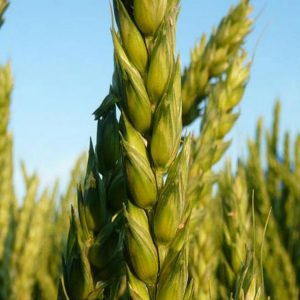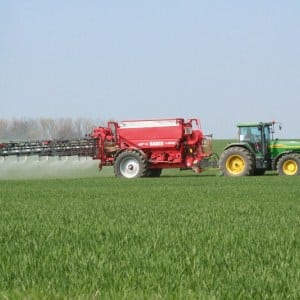Fertilizers for winter wheat: what to feed in the fall
Just as every housewife has her own recipe for preparing a signature dish, so every agronomist has his own secrets of growing plants. Unfortunately, a small harvest of winter wheat is a common problem that worries Russian specialists.
To make soils more fertile, farmers use fertilizers. What to feed wheat in the fall - you will find out from the article.
When to fertilize winter wheat

When preparing the soil for sowing wheat, it is necessary not only to carry out seasonal agrotechnical work, but also to introduce the norm of phosphorus and potassium fertilizers.
This will increase the plant’s immunity and allow it to safely endure the winter cold. Remember about the mandatory three fertilizing of the crop to maintain young shoots and stimulate them during flowering.
Adjust the fertilizing period taking into account the condition of the soil, weather conditions and crop development.
What is the importance of autumn fertilizers
Autumn feeding winter wheat involves the use of a full complex of necessary elements and vitamins. Before winter, fertilizers that directly affect the growth and development of the crop are of greatest value.
Phosphorus improves the formation of ears and facilitates the process of nitrogen absorption, potassium regulates protein synthesis, participating in cellular metabolism.
Optimal timing for fertilizing wheat in the fall
Autumn feeding is carried out before the end of the growing season or after it.
Reference. The growing season is the period during which wheat gains nutrients and grows.As a rule, it begins in the spring, when the air temperature reaches +5°C, and ends in the autumn, when the ambient temperature drops to -5°C.
In areas characterized by a non-flushing water regime, during the winter-spring period, nitrogen compounds along with moisture reach groundwater and remain at a depth of more than 4 m. Sodium elements remain available to plants during spring drought. This procedure is carried out in fields where the nitrogen content in the upper layers of the soil does not reach the required level.
For the full development of plants, the minimum supply of nitrogen in the spring is 110-130 kg/ha.
Necessary tools and materials for fertilizers

Using a trailed sprayer-2000 and a plant feeder (PZHU), liquid mineral fertilizer is applied.
The fertilizer seeder RTT-4.2A, NRU-0.5 and 1-RMG-4 are used for granular and powder mixtures. The RUM-8 semi-trailer is used for transporting and applying mineral fertilizers.
PRT-10, ROU-5, RUN-15B carry out the distribution of solid organic matter.
To apply organic fertilizers to the furrows, use MLG-1.
RZHU-3.6 and RZhT-8 are used for adding liquid organic matter. The tanks are mounted on a Soviet-made GAZ-53 truck, and the trailers are mounted on tractors. If necessary, fertilizer in liquid form is distributed using light aircraft.
Which fertilizers to choose
To decide on the choice of fertilizing, consider the available composition. For the full development of wheat, it is important to maintain a balance of elements that are required to improve quality and yield.
Nitrogen
When nitrogen fertilizer solutions enter the soil, they decompose into ammonia and carbon dioxide. This fertilizing is applied by the root method, additionally moistening the soil, in several stages:
- Before sowing, during cultivation work, the soil is fertilized with ammonium nitrate at the rate of 30 kg per 1 ha.
- During tillering, the plant especially needs nitrogen. This element affects the density and height of wheat bushes, as well as their fertility. However, nitrogen fertilization has no effect on grain quality. Nitrogen fertilizer is distributed at the rate of 35-40 kg/ha. During this period, apply at least 30% of the amount of nitrogen that needs to be applied for the entire season.
- Winter wheat needs nitrogen during booting. It has a beneficial effect on yield, i.e. it increases the quantity and quality of grains in the spikelet. Apply about 50% of the seasonal norm, i.e. 65-75 kg/ha.
- The remaining amount of fertilizer (about 20%) is added during heading and flowering of the crop. To get the maximum effect from fertilizer, ensure a high level of moisture in the soil.
When working with ammonium nitrate, follow safety regulations. This is an explosive substance.
The best fertilizer for caring for winter wheat can be called nitrogen fertilizing urea-carbide. This composition contains about 46% sodium. It is applied 5-7 days before sowing. Such deadlines are observed due to the fact that when it enters the soil, the fertilizer must take a form accessible to plants. Typically, this process takes 2-3 days.
Phosphorus
Phosphorus is extremely important for wheat during growth. It affects the synthesis of nucleic acids and increases the ability of wheat to absorb sodium. By influencing the development of microflora in the soil, it is not only important for the entry of phosphorus into plant cells, but also ensures the absorption of other elements.
For phosphorus to have maximum impact on wheat, it is important to maintain high levels of soil moisture.
Fertilizers are applied to a depth of 15-20 cm - 30 kg per 1 ha.
Potash
Potassium increases the nutritional value of grains. Deficiency of this element reduces plant resistance to cold. Potassium is especially necessary over a long period: from flowering to the beginning of heading.
Such fertilizers are distributed on the soil surface in preparation for sowing (30 kg/ha). The composition needs time to be absorbed. Often, potassium salt or sodium chloride is chosen as the source of the element.
Magnesium
Magnesium is necessary for proper protein-carbohydrate metabolism and is involved in saturating plant cells with oxygen. This significantly improves the quality of wheat. The maximum effect of fertilizing is achieved by applying it foliarly. Magnesium is better absorbed than phosphorus or potassium and is essential for proper phosphorus absorption.
The source is magnesium sulfate with a concentration of 16%. Apply at the rate of 15 kg/ha.
Sulfur

Compositions containing a high percentage of sulfur are necessary to optimize protein metabolism. If there is a lack of an element, the plant lags behind in development, turns white and dies.
Sulfur is also necessary for maximum sodium absorption. With its deficiency, nitrogen is not able to exert its influence on the quality of the plant. This is one of the most significant components for wheat.
The sulfur composition is applied simultaneously with nitrogen fertilizer during the preparation of the field for sowing. The source of the element is magnesium sulfate with a sulfate concentration of 16% or superphosphate, in which the sulfur concentration reaches 24%.
There is no standard application rate: the amount is determined individually and depends on the type of soil.
Organic
The difficulty with using organic fertilizers is that it takes time to break down the composition. It is distributed into the soil in the fall at a rate of 25-30 t/ha, so that by spring it is filled with the necessary elements.
To reduce the acidity of the soil, wood ash is added during plowing, calculating 3-5 c/ha. This effect lasts for two years.
This is interesting:
Maximum benefits in one glass: prepare and drink wheat germ juice correctly.
Description and characteristics of the winter wheat variety “Bagrat”.
Conclusion
To increase your winter wheat yield, follow the recommendations given in the article. If you provide the plant with a sufficient level of moisture in the soil and the necessary balance of elements, the result will not be long in coming. When choosing fertilizer for wheat, remember that imbalance will lead to loss of yield.